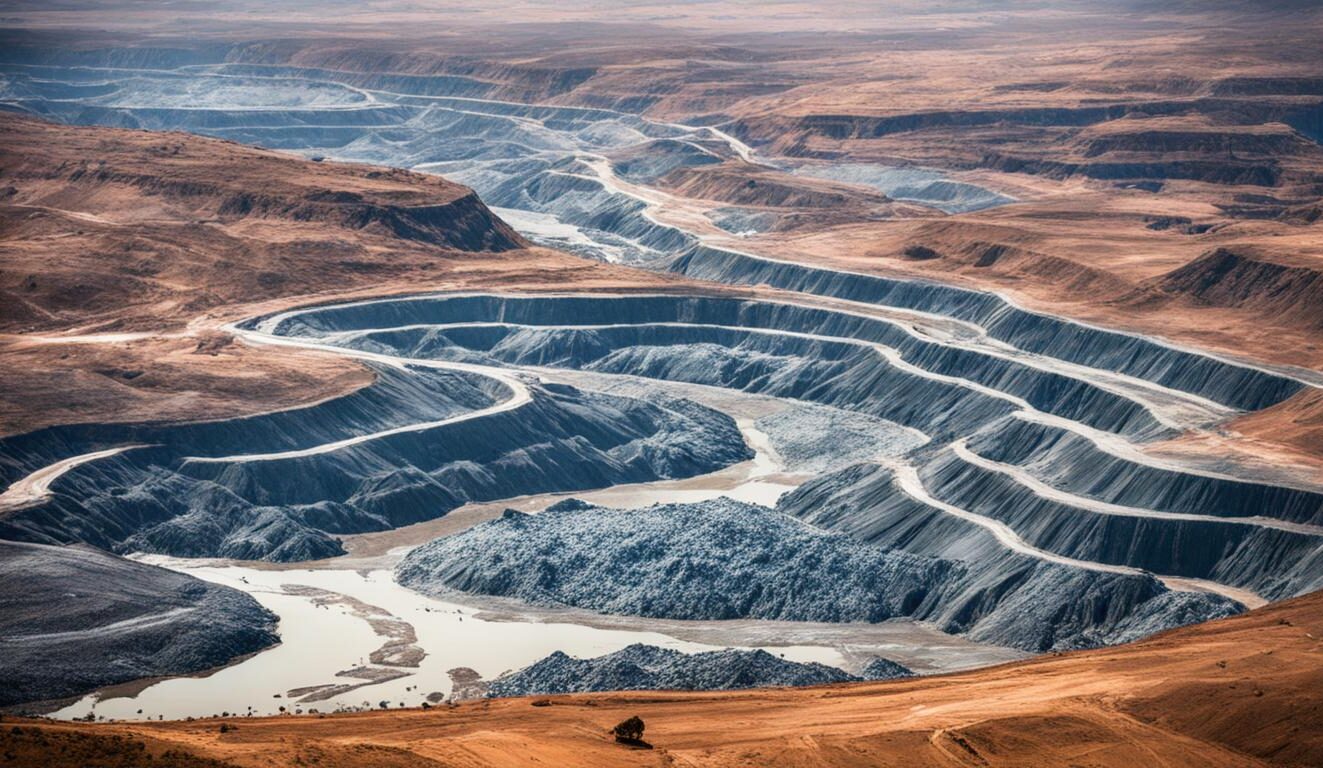The DRC Is Selling Its Own Copper for the First Time. Here’s Why.

The Democratic Republic of Congo (DRC) has made a groundbreaking move in the mining sector. For the first time, it is selling copper directly to the market. This change comes as Gecamines, the state-owned mining company, takes a more proactive stance in marketing its copper output. This output stems from joint ventures with major entities such as China’s CMOC Group and Glencore.
ALSO READ: Namibia’s Ban on Exporting Unprocessed Minerals: A Catalyst for Economic Growth
Previously, these joint ventures were solely responsible for copper sales. However, Gecamines is now directly engaging with the market, offering its copper share. The company is currently reviewing bids from leading traders like Glencore, Trafigura Group, and Mercuria Energy Group. These bids are for 90,000 tons of copper from the Tenke Fungurume mine, where Gecamines holds a 20% stake.
Key Takeaways
- The Democratic Republic of Congo (DRC) has started selling its own copper for the first time, marking a significant shift in the global mining landscape.
- The state-owned mining company, Gecamines, is now taking a more active role in marketing its share of copper production from joint ventures with major players like CMOC Group and Glencore.
- Gecamines is evaluating bids from major traders for 90,000 tons of copper from the Tenke Fungurume mine, in which it holds a 20% stake.
- This move allows the DRC to capture more value from its mineral resources and potentially increase government revenue.
- The DRC’s transition to selling its own copper could inspire similar moves by other resource-rich nations seeking to gain more control over their natural wealth.
Historical Context
The Democratic Republic of Congo (DRC) is renowned for its mineral wealth, housing vast reserves of copper, cobalt, and other minerals. It is the world’s primary source of cobalt, with 80% coming from industrial mines and 20% from artisanal operations. The DRC, along with Zambia, holds the second-largest global copper reserve, roughly a third the size of Chile’s.
Copper deposits in the DRC can reach over 5%, and some areas boast high cobalt concentrations, potentially holding 34% of global cobalt reserves. Yet, the nation has struggled to fully leverage its mineral assets.
Past Challenges in Benefiting from its Natural Resources
From 1970 to 1988, the DRC’s copper output ranged from 400,000 to 500,000 tonnes annually. This figure plummeted to under 50,000 tonnes by 1992-2001, before gradually increasing to about 300,000 tonnes in 2008. Political instability, corruption, and inefficient resource management have hindered the DRC’s exploitation of its minerals.
Efforts to review mining contracts began in 2008, aiming for equitable shares and social responsibility. Key players include Glencore, a Swiss firm with major stakes in several copper mines, and China Nonferrous Metal Mining Group (CNMC), which controls the Deziwa and Ecaille C mines. CMOC Group Limited, formerly China Molybdenum, entered the scene in 2016, acquiring the Tenke Fungurume Mine and the Kisanfu mine.
Gécamines, the DRC’s state-owned mining entity, has interests in mines like Kambove, Kipushi, and Kolwezi. It also operates a copper smelter at Lubumbashi and a hydrometallurgical plant at Shituru. Foreign investment, especially from China, has significantly shaped the DRC’s mining landscape.

The Mechanics of the Change
This change is being driven by Gecamines, the state-owned mining company. It plans to assess bids for 90,000 tons of copper from the Tenke Fungurume mine. Gecamines also intends to run tenders for its share of copper from the Glencore Kamoto operation and the Chinese-owned Sicomines project. These operations collectively produced over 400,000 tons of copper last year.
This shift also presents new opportunities for traders, who can now bid on sizeable contracts directly from the DRC. The Kambove joint venture has already produced copper worth participating in a tender bought by CMOC metals trader IXM.
“The Democratic Republic of Congo’s (DRC) decision to start selling its own copper marks a significant shift in the global mining landscape.”
The Tenke Fungurume Mine Partnership
The Tenke Fungurume mine is a key focus for Gecamines, with a 20% stake. This mine, a major copper and cobalt producer, is jointly owned by China Molybdenum Co. (CMOC) and Gecamines. Gecamines is currently evaluating bids for 90,000 tons of copper from this project, showcasing its growing role in marketing the country’s copper.
The DRC has surged to become the world’s second-largest copper producer, with exports nearly tripling since 2016. Gecamines’ new role in copper marketing is a strategic move amid growing global demand. This demand is driven by the expansion of electric vehicles, grid infrastructure, and data centers. As the DRC aims to maximize its mineral wealth, Gecamines’ entry into copper marketing is a pivotal development for the mining sector.
| Key Copper Projects in the DRC | Ownership Structure | Copper Production Capacity |
|---|---|---|
| Tenke Fungurume Mine | CMOC (80%), Gecamines (20%) | Over 400,000 tons per year |
| Kamoto Operation | Glencore | Over 200,000 tons per year |
| Sicomines Project | CMOC, Gecamines, and Chinese state-owned companies | Over 200,000 tons per year |
“Gecamines plans to run similar processes for copper from Glencore’s Kamoto operation and the Sicomines project, which together produced over 400,000 tons of copper last year.”
With Gecamines taking a more active role in marketing copper from this joint venture, traders can now directly engage with the DRC’s state miner. This could lead to more favorable contract terms. This shift in the global copper trade landscape could have significant implications for the industry.
| Copper Trade Indicator | Current Outlook | Potential Impact |
|---|---|---|
| Copper Contracts Availability | Increased | More opportunities for traders to bid on contracts |
| Contract Negotiation Terms | Potentially More Favorable | Increased competition among traders could lead to better terms |
| Tenke Fungurume Mine Significance | Substantial | A key focus for traders due to its size and Chinese investment |
Potential Economic Implications
The DRC’s economy heavily relies on commodities like copper, cobalt, tin, tungsten, and tantalum. With mineral resources valued at $24 trillion, it’s the largest copper producer in Africa and the world’s biggest cobalt producer. Selling its copper directly could increase the government’s revenue, potentially enhancing its financial standing.
Possible Impact on Congo’s Economic Development
The DRC’s economic growth has been rising, with a GDP growth rate of 8.6% in 2022. This growth is fueled by strong mining production and high export prices for copper and cobalt. The revenue from copper sales could fund investments in infrastructure, healthcare, education, and other vital sectors, accelerating economic development.
Yet, the long-term economic impact hinges on how the government manages and invests the additional revenue. Transparency and responsible management are key to leveraging this strategic shift in mineral marketing effectively.
“The DRC’s economy is largely dependent on commodities, such as copper, cobalt, tin, tungsten, and tantalum. The country is estimated to have mineral resources worth $24 trillion, with the DRC being the largest producer of copper in Africa and the largest producer of cobalt in the world.”
| Indicator | Value |
|---|---|
| DRC’s GDP Growth Rate (2022) | 8.6% |
| DRC’s Current Account Deficit (2022) | 2.9% of GDP |
| DRC’s Exports (2021) | $16.1 billion |
| DRC’s Exports to the US (2021) | $260 million |
| US Exports to the DRC (2021) | $216 million |
Global Market Ripples
Congo’s decision to sell its own copper could significantly alter the global copper market. The introduction of large copper contracts from the Democratic Republic of the Congo (DRC) may change how copper is traded and priced worldwide. Companies like Glencore and CMOC, which operate in the DRC, will have to adjust their strategies. This is due to the increased role of the Congolese state miner, Gecamines, in copper marketing and sales.
Shifting International Copper Trading
The DRC’s decision to sell its copper could shake up the traditional copper trade. New copper contracts from the DRC might affect the balance between supply and demand, impacting prices. Traders must watch these changes closely and adapt their strategies to benefit from them.
Reactions from Industry Giants
Companies like Glencore and CMOC, with major operations in the DRC, will be keeping a close eye on the country’s new copper marketing approach. They might need to reassess their partnerships and agreements to match Gecamines’ increased role in copper sales. Their responses and adjustments could spread through the global copper trade.
| Company | Reaction | Potential Impact |
|---|---|---|
| Glencore | Closely monitoring the situation | May need to renegotiate existing agreements and partnerships in the DRC |
| CMOC | Evaluating the implications for its mining operations | Potential changes in the company’s international copper trading strategy |
The DRC’s growing influence in the copper trade will be crucial for shaping the future of international copper trading. The reactions and adjustments of these industry giants will define this future.
Challenges and Concerns
Transparency and effective management of mineral resources are major concerns. The DRC has faced allegations of corruption and opaque dealings in mining, hindering its ability to fully benefit from its resources. As it becomes more involved in copper marketing, ensuring transparency and accountability will be under intense scrutiny.
Potential Obstacles in Implementing the New Strategy
The DRC’s aging infrastructure and transportation networks pose logistical challenges to the efficient distribution and marketing of copper. Coordination between Gecamines and its partners, with their diverse interests, will also be a challenge. Overcoming these hurdles is vital for the success of the DRC’s copper marketing strategy.
Concerns about Transparency and Resource Management
The DRC’s history of poor resource management and lack of transparency has raised concerns among stakeholders. As it becomes more active in the copper trade, fears of corruption and opaque dealings persist. Ensuring strong oversight, accountability, and fair revenue distribution is crucial to build trust and unlock the economic potential of the DRC’s minerals.
The DRC’s decision to sell its own copper is a major step, but it also highlights the need to address longstanding challenges in the mining sector. Overcoming these issues is essential for the DRC to effectively utilize its natural resources and drive sustainable economic growth for its citizens.
A Model for Other Resource-Rich Nations?
The Democratic Republic of Congo’s (DRC) decision to sell its own copper could set a precedent for other resource-rich nations. These nations aim to control their mineral resources and drive economic growth. If this approach succeeds, it may encourage other countries with vast mineral deposits to adopt similar strategies. This could lead to a global trend of resource nationalism.
This shift in the DRC could impact more than just the copper market. It might influence other commodity sectors and the global trade of resources. Being the world’s largest cobalt producer and a major copper and diamond producer, the DRC’s actions could reshape the mining industry worldwide.
Inspiring Change Elsewhere
The DRC’s decision to sell its copper might motivate other resource-rich nations to do the same. Countries like:
- Brazil
- Madagascar
- Myanmar
- Central African Republic
- Kazakhstan
could consider similar strategies. This would help them control their mineral resources better and benefit their local economies more.
Broader Implications for Resource Nationalism
The DRC’s move towards resource nationalism could start a global trend. It might inspire resource-rich nations to take back control of their mineral resources. This could lead to:
- More bargaining power for producing countries in talks with big corporations
- Getting a bigger share of profits from mineral resource extraction
- Changes in how international mineral resource trade works
With the growing need for mineral resources, the DRC’s action could lead to a big change in how the world views resource nationalism.
“The Democratic Republic of Congo’s decision to sell its own copper could serve as a model for other resource-rich nations seeking greater control over their natural wealth.”
The Road Ahead
The Democratic Republic of Congo (DRC) is shifting its copper strategy, focusing on selling its own copper. This move will be closely watched for several key factors. The success of Gecamines, the state-owned mining company, in marketing copper will be crucial. The response from major trading firms will also shape the industry’s future.
The DRC’s mining sector faces ongoing challenges like infrastructure limitations and transparency concerns. Yet, by leveraging the potential of its new copper marketing strategy, the DRC can unlock opportunities for economic growth. This could significantly boost the mining industry.
The Delicate Balance Between Opportunity and Responsibility

Yet, balancing the opportunity with responsible resource management and transparency is paramount. The DRC must tackle issues like child labor, environmental degradation, and profit distribution fairly. The international community will closely observe the DRC’s actions. These steps could set a precedent for sustainable development in other resource-rich countries.
FAQ
What is the Democratic Republic of Congo’s new initiative in the copper market?
The Democratic Republic of Congo has begun selling its own copper directly. Gecamines, the state-owned mining company, is now marketing its share from joint ventures. This marks a significant shift in the copper market.
Why is this move significant?
Previously, joint ventures sold the copper production. Now, Gecamines is marketing its portion, which amounts to hundreds of thousands of tons annually. This change could deeply impact the global copper trade. Traders can now bid on substantial new contracts from the DRC.
What is the key project Gecamines is focusing on?
Gecamines is concentrating on the Tenke Fungurume mine, where it owns a 20% stake. It’s offering 90,000 tons of copper from this mine. Major trading firms like Glencore, Trafigura Group, and Mercuria Energy Group are assessing these bids.
What are the potential economic implications for the Democratic Republic of Congo?
Gecamines’ increased marketing efforts aim to boost government revenue. This revenue could fund infrastructure, social programs, and initiatives for economic growth in the Democratic Republic of Congo.
How might this move impact the global copper market?
The DRC’s new copper contracts could alter international trading patterns and pricing. Companies like Glencore and CMOC, with operations in the DRC, might need to adjust their strategies. This includes working with Gecamines in the copper marketing and sales process.
What are some of the challenges and concerns with this new strategy?
Implementing this strategy could face hurdles like logistics, infrastructure, and coordination with joint venture partners. Concerns about transparency and managing the country’s mineral resources effectively must also be addressed for long-term success.
Could this serve as a model for other resource-rich nations?
If successful, this approach could encourage other countries with significant mineral resources to adopt similar strategies. This could lead to a broader trend of resource nationalism. It might also influence other commodity sectors and global resource trade dynamics.






Responses